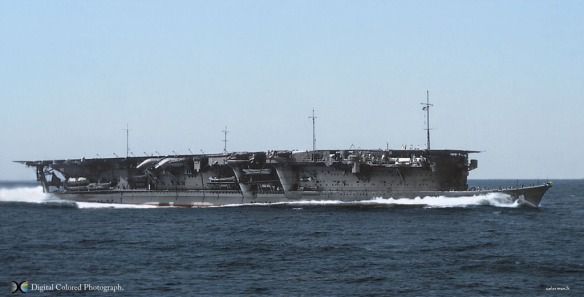Ryujo (Japanese: “prancing dragon”) was a light aircraft carrier of the Imperial Japanese Navy. She was laid down by Mitsubishi at Yokohama in 1929, launched in 1931 and commissioned on 9 May 1933. Her final design resulted in a top-heavy unstable vessel and within a year she was back at Kure Naval Yard for modification. With her stability sufficiently improved, Ryujo was returned to service and employed in operations during the Second Sino-Japanese War. Early on in the Second World War, she participated in subsidiary operations in the Philippines, Java Sea, Bay of Bengal and the Aleutian Islands before being sunk by American carrier aircraft at the Battle of the Eastern Solomons on 24 August 1942.
Builder: Yokohama Dockyard Company, Yokohama
Laid down: November 26, 1929.
Launched: April 2, 1930. Commissioned: May 9, 1933
Displacement: 8,000 tons (standard) 11,070 (full load)
Dimensions: 590’3” (oa) x 66’8” x 18’3”(mean)
Flight deck: 513’6” x 75’6”
Machinery: Geared turbines, 6 Kampon boilers, 2 shafts, 65,000 shp = 29 knots
Bunkerage & range: 2,490 tons = 10,000 nm @ 14 knots
Aircraft: 48
Armament: 6 x twin 5” AA, 24 x 13.2mm AA
Complement: 600
Design: The Ryujo was designed to fall below the limits of the Washington Treaty and thus not impinge on Japan’s available carrier tonnage. The Ryujo had two hangars, one above the other, with a flight deck above them that extended from the stern to the forward end of the hangars. Two elevators linked the hangars and the flight deck, which carried transverse wire arresting gear. The furnace gases exhausted through two downward inclined stacks on the starboard side. The navigation bridge was immediately below the forward end of the flight deck. The antiaircraft battery was carried on sponsons just below flight deck level on each side and had excellent sky arcs.
Modifications: The Ryujo’s instability problems, a consequence of attempting to incorporate full carrier features on such a limited displacement, necessitated a major refit between 1934 and 1936. Four 5-inch AA were removed and replaced by four 25mm AA. The hull was strengthened, ballast loaded, and the bulges enlarged, bringing the beam to 68 feet 2 inches. Displacement rose to 10,800 tons (standard), 13,650 tons (full load). Its draft increased to 23 feet 3 inches (mean) and the loss of freeboard led to a further refit in the winter of 1939 to 1940 that raised the forecastle to compensate. In 1942 six triple 25mm AA guns were added.
Service: The Ryujo operated off the Chinese coast, providing air support for operations in eastern and southern China. After a period as a training carrier, it returned to the front line covering assaults on the Philippines, Dutch East Indies, and Aleutians. It was sunk on August 24, 1942, during the Battle of the Eastern Solomons by aircraft from the USS Saratoga.
